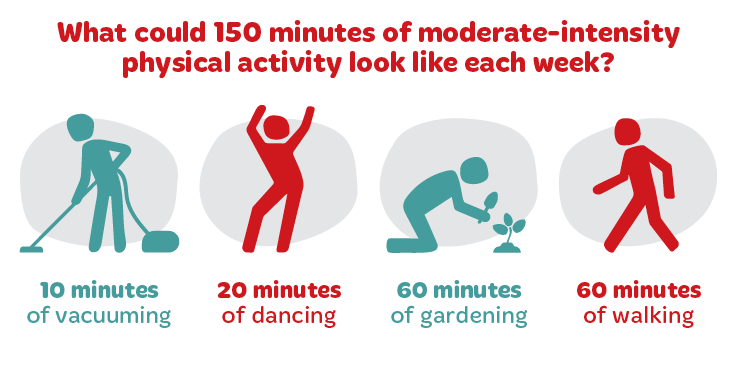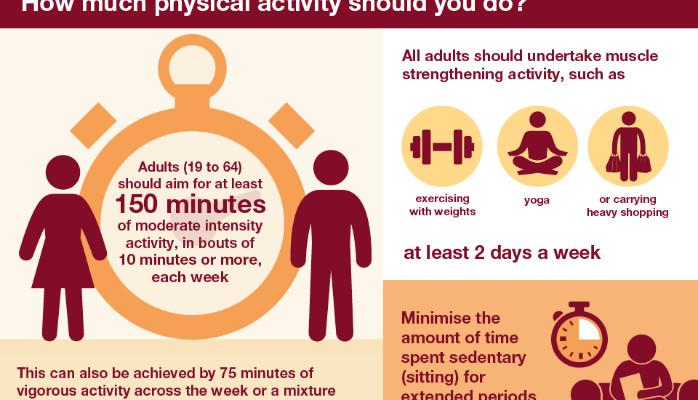Adults should aim for **150 minutes** of moderate or **75 minutes** of vigorous exercise weekly, plus strength training twice a week, for better health.
This article will break down the recommendations, benefits, and practical tips to help you achieve your fitness goals.
Understanding Exercise Recommendations:

General Guidelines:
According to the World Health Organization (WHO) and the Centers for Disease Control and Prevention (CDC), adults should aim for:
- 150 minutes of moderate-intensity aerobic exercise (like brisk walking) each week, or
- 75 minutes of vigorous-intensity exercise each week, like running.
For added health benefits, it’s recommended to increase moderate-intensity exercise to 300 minutes per week. These guidelines serve as a foundation for a healthy lifestyle, promoting cardiovascular health, weight management, and overall fitness.
Breakdown of Exercise Intensity:
Understanding the difference between moderate and vigorous-intensity exercise is crucial for tailoring your fitness routine:
- Moderate-Intensity Exercise: This includes activities that elevate your heart rate and make you breathe harder but still allow you to hold a conversation. Examples include brisk walking, cycling at a casual pace, or gardening.
- Vigorous-Intensity Exercise: These activities significantly increase your heart rate and breathing rate, making it difficult to talk in full sentences. Examples include running, swimming laps, or participating in high-intensity interval training (HIIT).
Also Read: What Oil Filter For Kohler Fits 725 Series Kohler Engine – A Complete Guide!
Strength Training:
In addition to aerobic activity, adults should also include muscle-strengthening activities on two or more days a week. These exercises help build and maintain muscle mass, which is essential for overall metabolic health. Strength training can include:
- Body-weight Exercises: Such as push-ups, squats, and lunges.
- Weightlifting: Using free weights or machines at the gym.
- Resistance Bands: A portable and versatile option for strength training.
The Benefits of Regular Exercise:

Engaging in regular exercise provides numerous physical and mental health benefits:
- Weight Management: Regular physical activity aids in maintaining a healthy weight by burning calories and increasing metabolism. Combining aerobic exercise with strength training can be particularly effective for weight loss and muscle gain.
- Improved Cardiovascular Health: Exercise strengthens the heart, improves circulation, and can lower blood pressure and cholesterol levels. Cardiovascular health is crucial for reducing the risk of heart disease and stroke.
- Enhanced Mental Health: Physical activity releases endorphins, reducing symptoms of anxiety and depression while improving mood. Exercise has been shown to have similar effects to antidepressant medications for some individuals.
- Stronger Muscles and Bones: Strength training builds muscle mass and increases bone density, reducing the risk of osteoporosis. This is especially important as we age, as muscle mass and bone density naturally decline.
- Improved Sleep: Regular physical activity can help you fall asleep more quickly and achieve deeper sleep. Exercise helps regulate your circadian rhythm and can alleviate insomnia symptoms.
- Increased Longevity: Studies show that regular exercisers tend to live longer and have a reduced risk of chronic diseases like diabetes, hypertension, and specific types of cancer.
- Enhanced Cognitive Function: Regular exercise has been linked to improved brain health, memory, and cognitive function. Physical activity increases blood flow to the brain, promoting new neuron growth and enhancing overall brain function.
- Social Benefits: Engaging in group fitness classes or sports can foster a sense of community and belonging. The social interaction that comes with exercising with others can enhance motivation and enjoyment.
How to Achieve the Recommended Minutes:
Create a Weekly Plan:
To meet the recommended exercise minutes, it can be helpful to create a structured weekly plan. Here’s a simple breakdown:
- 3 Days of Moderate-Intensity Exercise: Aim for 50 minutes each session (e.g., brisk walking, cycling).
- 2 Days of Vigorous-Intensity Exercise: Aim for 30-40 minutes each session (e.g., running, swimming).
- 2 Days of Strength Training: Focus on major muscle groups (e.g., weight lifting, yoga).
Also Read: What Size Television Can Fit 2201DS – TV Size Guide!
Find Activities You Enjoy:
Choose activities that you genuinely enjoy, as this will make it easier to stick to your routine. Whether it’s dancing, hiking, playing a sport, or joining a fitness class, finding joy in exercise will keep you motivated.
Exploring Various Activities:

- Group Classes: Try yoga, Zumba, or spin classes. The energy of a group can enhance motivation.
- Outdoor Activities: Hiking, biking, or kayaking can make exercise more enjoyable and provide a change of scenery.
- Sports: Joining a local team or league can add a fun, competitive element to your workouts.
Use Short Workouts to Your Advantage:
If finding time for longer workouts is challenging, consider breaking your exercise into shorter sessions. Even 10-15 minutes of activity several times a day can contribute to your weekly total and keep you active. This can include:
- Short Walks: Taking a brisk walk during your lunch break.
- Mini Workouts: Incorporating short body-weight workouts at home or during breaks.
Set SMART Goals:
Setting SMART goals (Specific, Measurable, Achievable, Relevant, Time-bound) can help you stay focused and motivated. For example:
- Specific: “I will walk for 30 minutes every day.”
- Measurable: Track your activity using a fitness app or journal.
- Achievable: Choose a realistic goal based on your current fitness level.
- Relevant: Ensure your goals align with your overall health objectives.
- Time-bound: Set a timeline for achieving your goals.
Also Read: Hks Super Air Filter Type 16 Honda Fit 2015-2020 – Performance Boost Honda Fit!
Overcoming Barriers to Exercise:
Many people face obstacles when trying to incorporate exercise into their routines. Here are some common barriers and tips for overcoming them:
- Time Constraints: If your schedule is tight, prioritize short, effective workouts. High-intensity interval training (HIIT) can provide maximum benefits in minimal time.
- Lack of Motivation: Find a workout buddy or join a class for social support and accountability. Mixing up your routine can also keep things fresh and exciting.
- Physical Limitations: Consult with a healthcare professional or fitness expert to design a workout plan that accommodates any injuries or limitations you may have.
- Cost of Gym Memberships: Many effective exercises can be performed at home with little to no equipment. Utilize online resources for free workout videos and routines.
FAQ”s
1. What counts as moderate-intensity exercise?
Activities like brisk walking, cycling at a casual pace, or gardening elevate your heart rate but still allow you to converse.
2. How often should I do strength training?
It’s recommended to engage in muscle-strengthening activities on two or more days each week.
3. Can I break my exercise into shorter sessions?
Yes, breaking exercise into shorter sessions of 10-15 minutes throughout the day can still contribute to your weekly total.
4. What are the benefits of regular exercise?
Regular exercise aids in weight management, improves cardiovascular health, boosts mental health, and enhances overall longevity.
5. How can I stay motivated to exercise?
Finding activities you enjoy, setting SMART goals, and joining group classes or workout communities can enhance motivation and accountability.
Conclusion
In conclusion, aiming for **150 minutes** of moderate-intensity or **75 minutes** of vigorous-intensity exercise each week is essential for maintaining good health. Incorporating strength training and finding enjoyable activities can further enhance your fitness journey. By setting realistic goals and overcoming barriers, you can make regular exercise a sustainable part of your lifestyle. Remember, every minute counts toward a healthier, happier you!